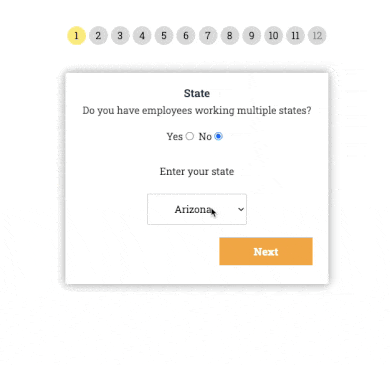

California employee handbook overview
When creating a California Employee Handbook, finding and including all of the required policies can be daunting. California has more required policies than any other state, including multiple cities that have their own required policies. Whether all of your employees are based in California or only a handful are, you will need to provide a California-specific handbook. This is important for employers because it keeps companies and employees aligned.
What’s unique about California employee handbooks?
While there are many policies required for all states that you will need to include in your California Employee Handbook, there are quite a few policies that California specifically requires employers to include in their handbooks. These policies apply to all cities in the state of California.
- California Paid Sick Leave Policy: California requires eligible employees to earn 1 hour of paid sick leave for every 30 hours worked. Employees can carry over up to 80 hours (or 10 days) of leave to the next year.
- California Anti-Harassment Policy: Anti-harassment training is required for companies with 5 or more employees.
- California Family Rights Act (CFRA): Employees are eligible to take up to 12 weeks of unpaid leave for themselves or to care for family members.
- California Religious Accommodations Policy: The California Workplace Religious Freedom Act requires companies to accommodate religious beliefs, including appearance.
- California Payroll Practices and Compensation Policy:Employers have specific responsibilities around payroll, pay periods, accrued vacation, and their final paycheck.
- California Make-Up Time Policy: Employees must be able to make up time missed at work for personal reasons under certain guidelines
- California Meal and Rest Periods Policy: Most workers are entitled to a 30-minute unpaid meal break and a 10-minute rest break.
- California Lactation Accommodations: Employers are required to provide reasonable accommodations for nursing mothers, including time to express milk in privacy.
- California Voting Leave Policy: Employees who do not have time to vote while the polls are open can take up to two hours of paid leave in order to vote.
- California Bereavement Leave Policy: Employees who work for companies with 5 or more employees may be entitled to bereavement leave following the death of a loved one.
- California Reproductive Loss Leave Policy: Employees may take up to 5 days of leave following the loss of a child.
- California Military Service Leave Policy: Leaveis granted for certain military service, as well as leave for military spouses.
- California Jury Duty Leave Policy: Companies must allow employees to respond to a summons to serve on a jury.
- California Disability Accommodation Policy: Employers must make reasonable accommodations for persons with physical or mental disabilities to apply for and work in jobs.
- California Literacy Leave Policy: Companies with 25 or more employees must provide accommodations or time off for literacy assistance.
- California Personnel File Access Policy: Employees must have the ability to review their personnel or payroll records.
- California COBRA (CAL-COBRA) Policy: Employees whose hours are cut or whose job ends are eligible to continue their benefits. The duration of the continuation is based on the employer's size.
- California Pregnancy Disability Leave Policy: Employees are provided up to four months of unpaid leave due to pregnancy, birth, or related conditions.
- California Time Off For Volunteer Firefighters, Reserve Peace Officers & Emergency Rescue Personnel: Certain emergency personnel are able to take up to 14 days off per year to carry out their duties.
- California Business Expense Reimbursement Policy:Companies are required to reimburse employees for necessary losses or expenses directly related to their ability to do their jobs.
- California Alcohol and Drug Rehabilitation Policy:Companies with 25 or more employees must provide reasonable accommodations to employees participating in drug or alcohol rehab programs.
- California Witness and Victims of Crime Leave Policy:Companies must provide leave for crime victims, including domestic or sexual violence. Companies cannot retaliate against employees for taking leave.
- California Bone Marrow and Organ Donation Leave Policy:Eligible employees may take paid leave for bone marrow or organ donation
- California Background Check Policy: Employers in California have specific responsibilities when conducting background checks on applicants or employees, including providing a copy of any reports.
- California School Involvement Leave Policy: Employees with children in in school may take up to 40 hours of unpaid leave per year for school activities.
California city-specific policies
Breaking down California city-specific policies
Many California cities have additional required policies if employees are based in one of the following cities. Here is a sampling of some of the most important policies required for each of these cities, followed by their breakdown. Policies for cities change frequently and this list is not exhaustive.
- Emeryville
- Berkeley
- Los Angeles
- Oakland
- San Diego
- Santa Monica
- San Francisco
City of Emeryville
- Emeryville Sick Leave Policy: Employers are required to provide employees based in the city of Emeryville, CA with paid sick leave.
City of Berkeley
- Berkeley Sick Leave Policy: Employers are required to provide employees based in the city of Berkeley, CA with paid sick leave.
City of Los Angeles
- Los Angeles Sick Leave Policy: Employers are required to provide employees based in the city of Los Angeles, CA with paid sick leave.
City of Oakland
- Oakland Sick Leave Policy: Employers are required to provide employees based in the city of Oakland, CA with paid sick leave.
City of San Diego
- San Diego Sick Leave Policy: Employers are required to provide employees based in the city of San Diego, CA with paid sick leave.
City of Santa Monica
- Santa Monica Sick Leave Policy: Employers are required to provide employees based in the city of Santa Monica, CA with paid sick leave.
City of San Francisco
- San Francisco Sick Leave Policy: Employers are required to provide employees based in the city of San Francisco, CA with paid sick leave.
- San Francisco Family Friendly Workplace Policy: Employers are required to provide certain employees with flexible work arrangements to assist with caregiving responsibilities.
- San Francisco Lactation Accommodation Policy: Employers are required to provide time and a private space for nursing mothers to express breast milk.
- San Francisco Mass Transit Commuter Benefits Policy: Certain employees are eligible to exclude certain commuting costs from taxable wages.
- San Francisco Paid Parental Leave Benefits Policy: Provides up to eight weeks of partial wage replacement for employees who need time away from work to care for family members.
City of West Hollywood
- West Hollywood Sick Leave Policy: West Hollywood Sick Leave Policy: Provides up to 96 paid hours of sick leave, vacation or personal leave to full time employees.
PAID SICK LEAVE LAW
California Paid Sick Leave
As of January 1, 2024, California requires eligible employees to earn 1 hour of paid sick leave for every 30 hours worked. Employees are allowed to carry over up to 80 hours (or 10 days) of leave to the next year.
Here are a few things to keep in mind:
- The law applies to both full-time and part-time employees
- The leave can be used for treatment or care of the employee or a family member, or for an employee who is a victim of domestic violence, stalking, or sexual assault
- Employers can limit the use of leave to 40 hours (or 5 days) in a 12-month period
- Use-it-or-lose-it policies are not allowed
- Employers can’t retaliate against employees who use this leave
Employers may also choose to frontload paid sick leave. If an employer wants to frontload leave, they can provide 40 hours (5 days) of paid sick leave.
The updated California paid sick leave policy is included in the state section of your employee handbook. You can reference the California SB 616 legislation.
Paid Sick Leave FAQ
Do sick days roll over in California?
Yes, employees can carry over up to 80 hours (10 days) of sick leave to the next year.
How many sick days do California employees get in 2024?
How does California sick leave work for a company that offers unlimited PTO?
What can employees use paid sick leave for in California?
Create your California employee handbook now
Federal Policies
Don’t forget about Federal Policies
There are policies required by federal law in all 50 states, and so they must be included in your handbook no matter what state your employees are based in. Some of the most important policies are outlined here, however, all federal policies should be included in your handbook.
- Equal Employment and Anti-Discrimination Policy
- Sexual Harassment Policy
- Family Medical Leave Act (FMLA) Policy (required for companies with 50 or more employees)
- Military Service Leave
- Get the full list of federal policies from the free handbook template builder
Additional Policies
Other Policies to Include in Your California Employee Handbook
- Workplace Violence
- Employee Conduct and Work Rules
- Conflict of Interest and Business Ethics
- Receipt of Non-Harassment Policy
- Receipt of Sexual Harassment Policy
- Health and Safety
- Confidential Company Information
- Insurance
- Workers’ Compensation
- Open Door Policy
- Equipment and Property Including Intellectual Property
- Sick Days
- No Solicitation / No Distribution
- Benefits Overview
- Use of Communication and Computer Systems
- Punctuality and Attendance
- Holidays
- Vacation Benefits
- Benefits
- Working Schedule
- Employment Records
- Inspections
- Smoking
- Pay Day
- Overtime
- Timekeeping
- Employee Categories
- Performance Reviews
- Lactation Breaks
- Direct Deposit
- Company Vehicles
- Personal and Company Owned Communication Devices
- Personal Visitors and Telephone Calls
- Hiring Relatives
- Business Expense Reimbursement
- Social Media Policy
- Introductory Period
- General Handbook Acknowledgment
- References
Employee handbook requirements by state
Click on a state to learn more about policies and recommendations.
California labor law posters
Understanding labor law poster requirements can be a bit like trying to decode a complex puzzle. You need to comply with both state and federal requirements.
Why Should I Care About Displaying Posters?
You might be wondering why it's so important to display these posters in the first place. State and Federal laws mandate that employers must have up-to-date labor law posters conspicuously displayed for their employees. Failing to do so not only results in steep fines (up to $35,000 in federal fines and additional state fines) but also exposes you to real liability.
Consider this scenario: if an employee decides to bring a lawsuit against your company, and you don't have the required posters or they are outdated, you could face even more significant problems:
- Statute of Limitations: Normally, there's a limited window within which an employee can file a lawsuit against you. However, if you didn't inform your employees of their rights through proper poster display, a court might decide that the statute of limitations doesn't apply.
- Operating in Bad Faith: Courts may determine that you were intentionally withholding information from your employees, which could lead to a finding that you were operating in bad faith. This can substantially increase your liability.
What Are the Requirements for Displaying Labor Law Posters?
Labor law posters must be displayed at every physical location where you have employees, and they need to be conspicuously displayed for all to see.
- If you have a hybrid workplace with both in-person and remote employees, you'll need physical posters at your facilities and electronic distribution to your off-site workers.
- For fully remote companies, you can distribute posters electronically by sharing a permanent link to the appropriate posters.
- Some posters also need to be visible to job applicants, such as FMLA, Equal Employment Opportunity, and Employee Polygraph Protection posters, as per the guidance provided by the Department of Labor.
What Labor Law Posters Do I Need to Display?
You'll need both Federal and State labor law posters for each state where you have employees. The good news is that all the posters you need are provided for free by the federal government and state departments of labor. You've probably seen those convenient "all-in-one" laminated posters, but if you prefer, everything you need is also available as a free, printable document from the California Department of Labor.
Federal Poster Requirements
Determining which federal posters you're required to display can be influenced by various factors, including your industry, the size of your company, benefits you provide and union affiliation.
The good news is that there's a handy tool to help you understand precisely which federal posters your company needs. You can use the Federal Poster Advisor tool to determine your specific federal poster requirements.
California Labor Law Poster Requirements
You can refer to the California Department of Labor for free, printable posters.
Download California labor law posters hereCalifornia pay transparency law
Pay transparency laws mandate that employers disclose salary ranges for positions to job applicants, and sometimes even to existing employees. The primary objectives of these laws are to reduce gender and racial wage gaps and to foster a more equitable and competitive job market. These laws vary in terms of scope, with some applying to all employers and others targeting businesses of a certain size or type.
- California’s pay transparency law requires companies with 15 or more employees to provide the pay scale for a position. Additionally, employers must maintain records of job titles and wage history for each employee, which can be used for compliance purposes.
- Employers are not allowed to ask a job applicant about their salary history.
- Employers are required to disclose salary information to current employees upon request.
- Penalties for non-compliance range from $100-10,000 per violation.
Learn more about pay transparency laws by state
What’s included with the handbook builder
Creating a new handbook only takes a few minutes. And it’s easy. You can get started by answering a few interactive questions about your company. A few examples:
- How many employees do you have?
- Do you have employees in multiple states?
- Do you have an introductory period for new employees?
- Do you offer paid holidays?
- What is your payroll schedule?

Communicating your company culture
In all businesses, building a strong company culture can be essential to boosting morale and aligning employees. Arguably, it is even more key for small businesses. With a small team, the impact of a strong culture is made more apparent. Here are some important things to remember when building a strong company culture.
Evaluate Your Current Culture
Since company culture is primarily determined at the top, here are some key questions to ask your leadership team to evaluate where your culture currently stands:
- Are we open about how things work at our company?
- Do our employees know what is expected of them?
- Do we value our employee’s feedback?
- How do we demonstrate that our employees are valued?
- What are our company values?
- Do we clearly express these values?
Set Your Goals
From your answers to the previous questions, pinpoint what is lacking and make goals to improve on those areas. This could mean having clearer communication for employee expectations, defining company values, or creating monthly team-building activities to build morale.
Respecting Employee’s Work-Life Balance
A large part of communicating that your company values its employees is demonstrating respect for their lives outside of work. A strong employee handbook can allow this to be done in a clear, effective way. Company leaders should detail expectations, but also be open about their own work-life balance to build transparency. Trust is key in a great company, and when leaders show genuine empathy for employee responsibilities at home, a foundation for transparency and cooperation is built.
The Link Between Culture and Happiness
Many surveys and analyses of employee feedback indicate that the majority of employees care as much about the culture of the company they work for as their salary. In small companies, culture is frequently undervalued. In order to reduce turnovers and increase recruitment, companies need to understand that there is a link between strong culture and the one important question employees think about regularly: “Am I happy working here?”.
Understanding and Communicating Your Company’s Culture
In order to effectively communicate your company’s culture, you need to understand it. By asking your team the right questions, setting goals, and valuing employees, you can be sure to be on the right track.
Communicating this culture is an essential next step toward aligning with your employees. Not every culture is a good fit for every employee, and being honest upfront is important for making sure you are hiring employees best aligned not only with the skills a company requires, but the culture of the workplace. Research shows that when looking for a job, 77% of people polled would consider a company’s culture and work atmosphere before applying. By clearly communicating your company culture up front, you can ensure that more candidates who align with your team values will apply for a position.
Creating an editable handbook
How to create your new small business handbook
- Get an up-to-date handbook
- Edit online or download Word Doc
- Includes essential policies
- EEOC, harassment and discrimination policies
- Customizable optional policies
Employee Handbook Resources
Best practices, guidance and information for companies